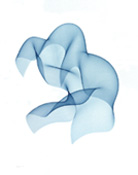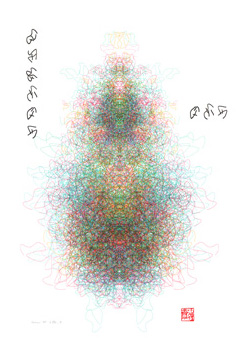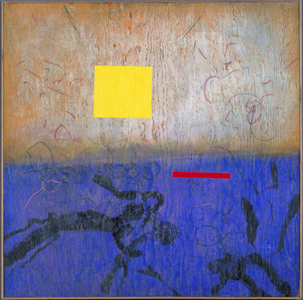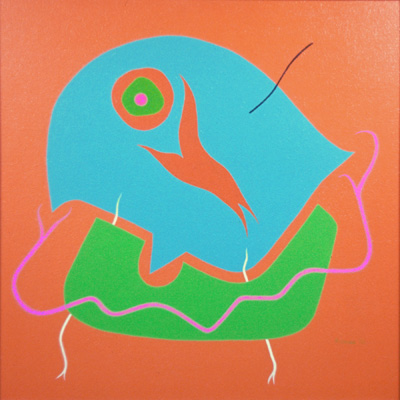Imaging the Unseen
A statement on my pursuit as an artist
Roman Verostko, 2004

algorithmic
pen & ink drawing, 2003

Gaia, Celebrating Earth, 1995
algorithmic pen & ink drawing
My art-work emerges from the tradition of early 20th Century pioneers who sought to create art using pure visual form. The theory and practice of Mondrian, Kandinsky and Malevich led me to explore what Henri Focillon identified as "the life of forms" in art. Since then, as an artist, I have engaged both arbitrary and constructive procedures experimenting with "visual form". Since 1960, in all my work, I have sought to create original forms that are unique realities without reference to other objects or images. My pursuit followed the lead of those pioneers who wanted to create an art using visual form much like a composer creates music with audio form.
Transition to form generators.
In 1970, through a programming course at the Control Data Institute in Minneapolis, I experienced the awesome "form-generating" possibilities of coded procedures coupled to computing power. Clearly the dreams of the pioneers could be realized! With this technology we could create instructions for generating visual forms; we could now compose the "score" for drawing!
With the advent of personal computers, I began writing elementary drawing instructions, "algorithms", that mimed some methods I had been using to create art forms. The awesome power of recursive drawing drew me to a full commitment and studio conversion. Since then my work has concentrated on developing and refining a program of procedures based on my practice as a painter. In my current work all forms are generated with original algorithms.
These procedures have brought me to a new frontier of visual forms, forms we could never envision without algorithmic recursion driven with computing power. These art forms do not describe or refer to other realities - rather they have a visual life of their own.
Titles.
Titles for specific works or a series of works are usually derived from an evocative quality or association I find in the work. Often my works are simply given a composition or series number. The works therefore do not refer to events, ideas, objects, or subjects. They are objects to be experienced for their visual form similar to the way one might experience a musical form.
Meanings.
For me these forms are visual celebrations of information processing procedures embedded in today's culture. The works are visual analogues of the coded procedures by which they grew. They invite us to ponder how the stark logic of a coded procedure yields such surprising grace and beauty. By doing so they serve as icons illuminating the mysterious nature of code, the procedures underlying the shape of our evolving selves.
Technical Procedure.
By 1982 I had developed some elementary instructions for initiating and improvising art-form ideas. These instructions included "form-generating" routines based on my experience as an artist. With these generators I could explore form possibilities, make choices, refine forms, and compose a procedure for creating my art work. The finished work is drawn with ink pens mounted on the drawing arm of a pen plotter. Controlling algorithms for all procedures are under continuing development in a program of routines I have titled "Hodos", the Greek term for "pathway".
Materials.
Most of my algorithmic works are original pen and ink drawings on rag paper. Technical pens with refillable inkwells employing permanent acrylic inks execute the drawings. Since the mid 1980's all drawings have been executed with Houston Instruments multi-pen plotters coupled to PC's. Currently I use HI 7000 machines coupled to PC's operating on DOS. Note that some works do include occasional brush strokes. In those instances brushes were mounted on the plotter's drawing arm in lieu of ink pens. Oriental self-inking brushes have been used like pens in some instances. Alternatively I have devised an interactive routine with the pen plotter; the routine pauses the machine, as needed, so I can load a paint brush and mount it on the pen plotter for the brush strokes.
The Code.
My software is written in elementary BASIC with DMPL as the command language for driving the plotter. Historical routines dating back to the 1980's can be called on from the controlling program. A new work could be created today with routines dating from the 1980's.
As an artist my great interest has always been mastering a technique for creating an art object. Elementary pen plotting tools and simple programming techniques have provided me with more challenges than I can exhaust in my lifetime. After more than 40 years and thousands of drawings I have learned a lot about ink viscosities, pigments, paper surfaces, the honing of pen tips, and writing software fixes. Yet, I feel like I have only begun to explore the art of drawing with pen and paper.
More on theory and practice at http://www.verostko.com/practice.html

